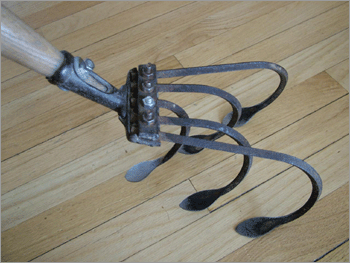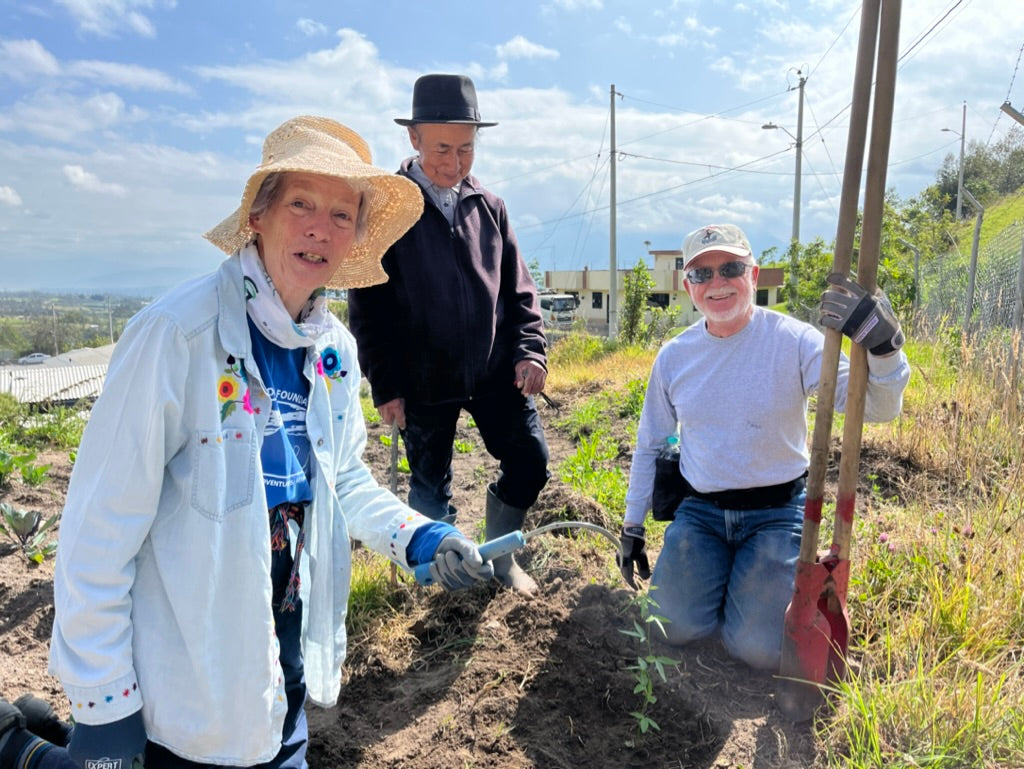A note from our Founder, Noel Valdes ~
CobraHead® was launched back in 2002 when I got curious tinkering in my own backyard. The initial idea for the CobraHead® Weeder and Cultivator, came to be when I was working with an antique tool and a tine loosened and fell off. Scratching the dirt with the single tine, I decided that the digging and cutting ability of the blade might make it a handy weeder. I mounted the blade into a short handle sized piece of wood and began grubbing around in the garden. It became readily apparent that the tool worked very well as a weeder and also did a reasonably good job of cultivating and digging small plants for transplanting.
That antique tool was a long handled five-tined cultivator. Thousands of these tools were manufactured in the first half of the 20th century by quite a few manufacturers and many models. The level of quality varied vastly, but the best tools featured well made replaceable blades forged of high quality steel.
I still use these old cultivators instead of a power rototiller because they are superior for the raised bed type of gardening we do. They involve labor, but they are efficient and the good ones last forever. They are also superior in ground cutting action to any of the tined cultivators being marketed today, but the market likely collapsed for these excellent tools because of the acceptance of the powered rototiller after World War II and the fact that the tool requires the use of significant manual labor.
 |
 |
|
| Five Tined Cultivator Hoe | CobraHead® Weeder and Cultivator |
So I began to tinker by modifying the blade design from that extremely popular antique garden tool. I improved the usefulness by inserting the blade into a wooden replacement hammer handle. This made the tool much more comfortable and efficient. After using the tool for a season, I decided that it had market potential, but I needed to find out two things before deciding to try to market it. First, was it really as good as I thought it was? Second, was someone else already making something similar and was it protected by a patent?
To prove it was the best, I bought all the similar tools I could find and compared them to my own creation. After trying most of the best selling hand held weeders I was convinced that the antique blade design, which could be compared to the tine of a tractor cultivator, cuts ground so effortlessly compared to all other tools that it could easily outperform the tools on the market known as the best weeders. It would require modification to the blade to make it more useful as a small hand tool, but I was certain it would be an exceptional device.
In contacting a patent attorney, I was introduced to a program for inventors run by the University of Wisconsin - Whitewater. Their program included running a patent search and a marketing study, and as a result it was determined that the exact product was not currently being made. No patents appeared to exist for the tool, and the market seemed large enough to support another garden tool, if it were unique, so the business was launched in the year 2002.
I have always been an organic gardener and committed to the sustainable approach to life so I made it my mission to have the tool made locally instead of overseas. The Midwestern U.S. used to have a huge tool industry, so I assumed there was bound to be some remnants of that left in Wisconsin. This actually proved to be an incorrect assumption as only two Wisconsin firms were found who could produce the small forging required for the tool. One, the largest manufacturer of lawnmower blades in the US, blew us off after the initial inquiry, so the ability to get the tool "Made in Wisconsin" went down to one firm.
A Green Bay, Wisconsin firm, Green Bay Drop Forge, specializing in small forgings for the automotive industry, was capable of making the blade. They showed exceptional and friendly encouragement in helping us get the tool designed and made. They developed prototype-manufacturing prints and established tooling and manufacturing costs for both prototype and full production runs. An order for tooling and a 1,000 piece sample run was given to Green Bay Drop Forge on July 20, 2001.
The pre-production prototype models of the tool used a wood replacement hammer handle. The original production handle was injection molded plastic in the same hammer handle shape. The plastic handle was stronger and cheaper than wood. While the first tools used a virgin plastic strengthened with agricultural filler (flax shive) for strength, the tool handle is now extremely environmentally friendly, with the plastic content 100% post-industrial recycled polypropylene and the strengthening fibers either 100% post-consumer recycled wood fiber or flax fiber.
An injection molding firm produces this handle. The handle making process includes mounting the blade in the handle as part of the operation so the manufacturing process is fully complete at the injection molder.
The result of my tinkering and genuine enjoyment of getting my hands dirty is a truly inventive and unique tool in the gardening space. It is probably the most versatile and useful small weeding and cultivating device on the market. The same or even a closely similar tool had not been manufactured by anyone else. In recent years I have seen a few knockoffs emerge on the market, but as with most knockoffs, none are truly the Original CobraHead with matched quality and ergonomics. I'm so pleased to say that the Original CobraHead® Weeder and Cultivator is now used worldwide as a multi-purpose hand tool for use in gardening, horticulture, and agriculture. It has been enthusiastically endorsed by the best garden writers and horticulturists in the US, Canada, and the United Kingdom.

A totally unique tool
Think of the CobraHead® blade as a "steel fingernail®" and its functionality becomes readily apparent. It's a great weeder for all types of weeds. It's not only a great weeder, we've actually had gardeners tell us that it makes weeding fun! It digs and cultivates and does a lot of chores that used to require multiple tools.
After all the years of wonderful feedback we've tagged CobraHead - the best tool in earth®. Gardeners who use the tool know we aren't just throwing out marketing fluff with that statement. We humbly know, there is not a better small weeder out there!

Planting a greener future together.
Our community of CobraHead growers use our tools to promote joyful gardening, horticulture, and agriculture. We love being a part of cultivating a sustainable lifestyle for generations to come across the globe.
Our mission is simply to make getting your hands dirty easier and more enjoyable whether you're planting a few tulips or small-scale farming.

CobraHead Long-Handle
We began developing a long-handled CobraHead version soon after we introduced our original CobraHead Weeder and Cultivator. It quite honestly was a reaction to older gardeners who at trade shows kept telling us, "that looks great, but I need it on a long handle." When we got serious about making a long tool, we realized that just sticking the CobraHead blade on a hoe handle was not going to produce a very effective tool. We tested many blade shape configurations before we determined that positioning the blade so it was perpendicular to the handle gave us a totally new tool that was a useful device for gardeners of all ages and a vast improvement over similar narrow bladed tools that were previously marketed.
We also had to do a lot of work on developing an effective handle. The recycled plastic composite we use for the short tool cannot be used in a long configuration. We settled on a very traditional wood hoe handle. We also had to develop a locking collar that allows the user to replace the blade should it break. The collar gives the tool enough heft to make it effective in tough soils. It doesn't just bounce off hard clay, but cuts into it. Bowman Handles in Batesville, Arkansas manufactures the wooden handle for us using North Carolina Ash.
Older gardeners and those who have trouble getting down on their hands and knees are quite happy with what we came up with, but we find we now have a market for the tool with small scale farmers, landscapers and of course both the vegetable growers and ornamental gardeners that make up most of our customer base.

Embracing
a greener lifestyle
We are dedicated to producing high-quality products with sustainability at the core. Our joy is providing high-quality hand tools for gardeners and growers.
We love helping others be better gardeners whether you're a blossoming horticulturist or just someone who wants to pull a few weeds in their backyard with a lot more speed, ease and comfort.
Our Team
Founded in 2002, CobraHead is a family owned and operated business, Headquartered in Wisconsin, USA.
-

Noel Valdes
Founder
Noel is the CobraHead inventor, Chief Tinkerer, and a long-time hobby gardener who is convinced the world would be a much better place if everyone gardened. He has a robust garden in his backyard, growing lots of morsels in open raised beds. Noel could be called "Mr. CobraHead", and well, he has been.
-

Judy Valdes
Co-Founder
Judy wears the most hats including Chief Financial Officer, Traffic Manager, Customer Service Rep, Packaging Specialist, and Primary Family Chef. She urges the rest of the team to think practically. She's been involved in customer service work most of her career and leads those efforts at CobraHead.
-

Anneliese Valdes
Operations
Anneliese swaps between the roles of Office Manager, Shipping Manager, Social Media Manager, and general Jill-of-all-Trades at this family-run business. She enjoys keeping her parents on their toes. She has been playing bass guitar in her local Madison band Gentle Brontosaurus since 2016.
-

Andy Young
Inventory & Quality
Andy rounds out this crew ensuring orders ship perfectly and with ease. He grew up in the Madison, WI area and is a University of Wisconsin-Madison alumni - Go Badgers! He loves dabbling in photography, traveling, beautiful parks, and time spent with his beloved fur children Bijou, Ember and Hazelnut.
Featured in
 1-608-423-9119
1-608-423-9119







